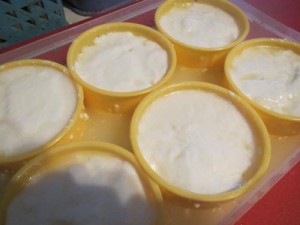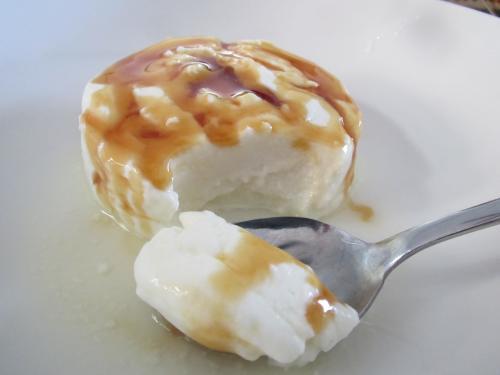Faisselle is a cheese that’s not well known outside its native France. It’s a soft cheese that is versatile enough to be used as a dessert or savoury food. I love it so much, I have now made it a staple of our diet.
The problem—well, one of the problems—of making cheese in Malaysia has to do with milk. Sometimes, days can go by without being able to get fresh milk and UHT milk won’t work with cheese-making, because the heat (Ultra-Heated) destroys the bacteria necessary for incubating the necessary cultures. I have successfully made faisselle with milk powder and suggest you do the same if you want a lovely, light yet rich result.
Here are the ingredients:
- 2.0 L of milk made from milk powder and distilled (or boiled and left to cool tap) water
- 200-250mL cream (you can only get UHT cream here…oh well)
- ¼ tablet vegetable rennet
- Two pinches mesophilic culture (use the tip of a small vegetable knife as a pinch)
- Patience
- Add cream to milk and stir.
- Heat the milk to 30 degrees Celsius, stirring the saucepan to make sure the milk at the bottom doesn’t overheat.
- Take off the heat.
- Sprinkle the mesophilic culture over the surface of the milk. Leave for 2-5 minutes.
- While the culture is rehydrating, mix the vegetable rennet (you can use a pestle to crush it up) in 50mL of distilled water. (I’m telling you to do this at this stage because rennet in liquid loses its potency after 20 minutes.)
- Stir the culture you sprinkled into the milk gently.
- Add the rennet mixture. Stir in gently. Try not to form any bubbles while you’re doing this.
- Cover and leave for 12-20 hours.
If I start at 2pm, I put the covered saucepan in one corner of the kitchen and leave it till the following morning. It doesn’t need to go in the fridge, even in our tropical heat, but make sure it’s in a fairly sheltered spot.
After about four hours, you can see if it’s ripening by touching the surface of the milk with a finger. It should feel a bit rubbery, or at least not completely liquid. Now Leave It Alone.
Faisselle is a cheese that’s stored in its own whey. I wasn’t quite sure how that was going to work, but it turns out just fine.
I didn’t have any faisselle (that’s actually the name of the moulds), so I went to our Japanese $2 store (Daiso) and bought two packs of “ice cups” (three cups per packet). Then I sweet-talked J into drilling holes into each of the six cups.
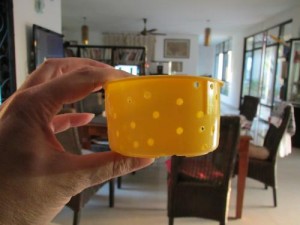
Make sure you do it from the inside out, so the cheese can unmould without tearing itself against the rough inside edges. Through sheer luck, the six of them fitted perfectly in a freezer container I had.
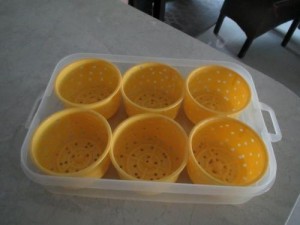
The following morning, you should find that the cheese is a solid, with a thin layer of faint yellow whey floating on top. Using a spoon and gentle movements, scoop the curds out of the pot and into the six moulds, which are sitting in the freezer container. They should start to drain whey right away.
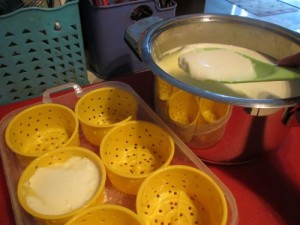
Cover and put in the fridge once you’ve filled the cups. I always make extra so I can do a second “style” of cheese. What doesn’t fit into the small cups gets put into a tofu mould and drained for an hour. You’ll notice that I put it back in the saucepan to drain, on top of an overturned container. This is because I save the whey.
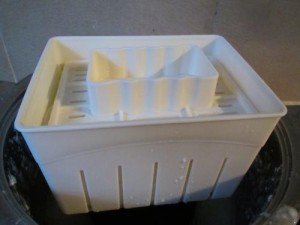
What you get tastes like a thick, very rich, sour cream spread.
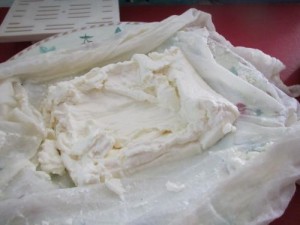
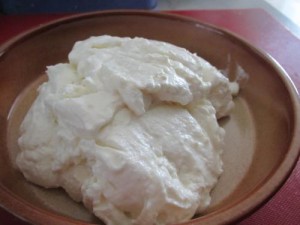
I don’t add any seasoning to either curd type, so can use it for a salad or a dessert as the mood takes me. Here’s my breakfast from a previous batch (I usually take a cup out of the bigger container and drain it 15 mins before unmoulding), topped with some lovely local saffron-enriched honey:
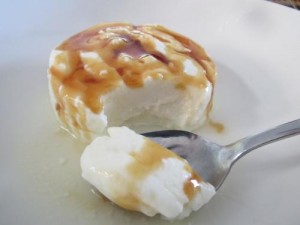
It’s also lovely “decorated” with a big spoon of cherry jam.
Questions
So you’re saying I can make cheese with milk powder?
–Yep.
Where did you get your rennet and culture from?
–I mail-order it from a great company called New England Cheesemaking Supply Co. The minute my order arrives, I pop everything into the freezer. Hey, if it works after flying across the United States and Pacific Ocean, before bouncing from state to state in Malaysia, it’s bound to work wherever you are!
Why don’t you use the liquid rennet? Isn’t it easier than dealing with the tablets?
–Yes, but I’ve read that the liquid rennet loses potency quicker than the tablets, so I decided to play it safe and go with the tablets.
Do you use vegetable or calf rennet?
–For soft cheeses, I use vegetable. When J finishes making my cheese press (waiting, waiting) and I’m ready for something more ambitious, I’ll use calf rennet. This is because I’ve read that vegetable rennet leaves a bitter taste in aged cheeses. With faisselle, it never lasts long enough to see!
How long can I leave the faisselle for?
–Up to six days in the refrigerator. If you have any older than that, feed it to the dog.
Which milk powder did you use?
–I use New Zealand skim milk powder. The batch you see was made with Sunlac brand. I also have a bag of Fernleaf, but haven’t tried that yet. Remember to add a small packet of cream to the milk to add more richness to your cheese. You won’t regret it.
What do you do with the whey?
–Whey tastes different, depending on the type of cheese you make. The whey from faisselle is tangy, but not unpleasant. You can use it as liquid in sauces or stock in soup. We drink it and use it as our liquid in bread-making (the kids are on rotation for bread-making duty. This started when LD (our daughter, Little Dinosaur) was twelve, so if you have teenagers, put ’em to work!). I also give some to Sausage (mini bull terrier mascot and Garbage Disposal Officer) as an occasional tonic.
I like faisselle because I get a lot of cheese from very little culture and rennet. It has a yield of 55-75%, which is much greater than most cheeses that only give a yield of around 15-20% cheese to whey. It’s economical and it tastes great. If you’ve never made cheese before, faisselle is a great place to start, and it doesn’t require much milk (you can easily halve the quantities if unsure) so it’s not much risk. Try it and see how it goes.
